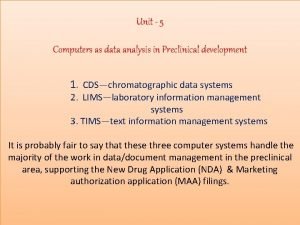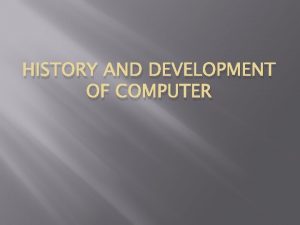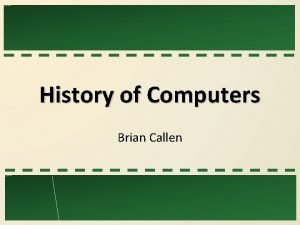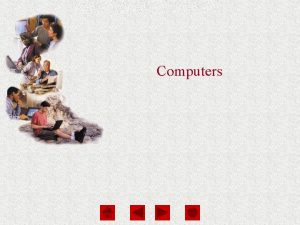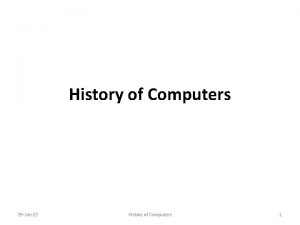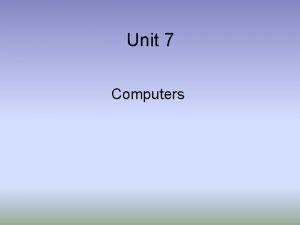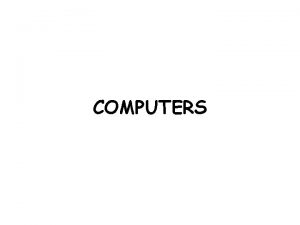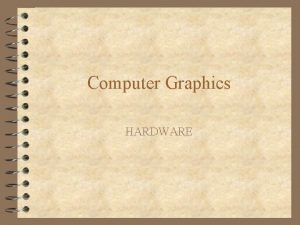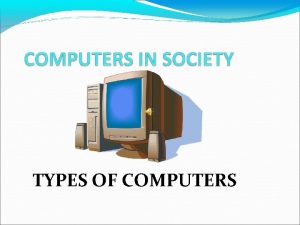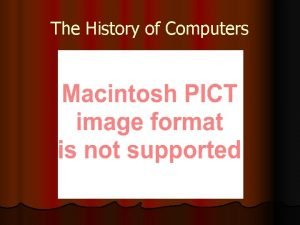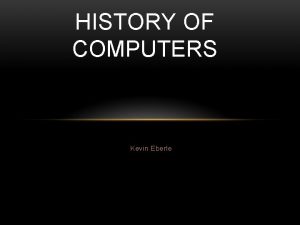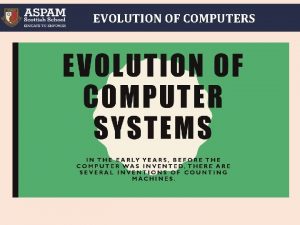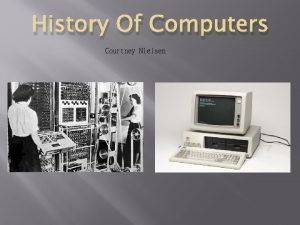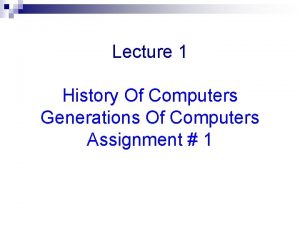History of the Computer History of Computers Development


















- Slides: 18

History of the Computer

History of Computers • Development of computers began with many early inventions: – The abacus helped early societies perform computations (c. 3000 B. C. ) – The Pascaline used moveable gears to add numbers with up to eight digits (1642).

Abacus

Pascaline

Nineteenth-Century Inventions • The nineteenth century brought further inventions: – Charles Babbage’s Difference Engine and later his Analytical Engine defined many basic components of today’s computers. – Herman Hollerith developed a system to aid in tabulating data from the 1890 U. S. Census using punch cards.

Babbage’s Analytical Engine 1833

Hollerith Punch Card Machine 1890

First-Generation Computers During World War II, the first generation of modern computers was introduced. They were considered • single purpose computers • which used large bulky vacuum tubes, similar to light bulbs, to do the switching in its logic circuits. – Colossus was developed in England to decode encrypted German messages. – ENIAC was developed in the U. S. to calculate ballistic missile trajectories. – EDVAC was designed by John Von Neumann and it featured a central processing unit. – UNIVAC was the first commercially available computing device.

The Vacuum Tube

Colossus - 1943

ENIAC - 1946

EDVAC

UNIVAC 1954

Second-Generation Computers The second generation of computers (c. 1956) was marked by: – A shift from bulky vacuum tubes to transistors. – A shift in programming from physically rerouting cables to “software” stored on punch cards and tape storage. – The emergence of machine and assembly languages.

The Transistor

Third-Generation Computers • With the invention of integrated circuits (ICs), computers became smaller and more powerful. ICs: – Are smaller than transistors – Produce less heat – Allow multiple components to fit on a smaller chip

Integrated Circuits

Fourth-Generation Computers • Computers became smaller and more affordable, and available to small businesses and individuals. – MITS Altair 8800 (1974) – Apple I, II – Commodore PET – IBM PC (1981) – Macintosh (1984)
 Elements of computer
Elements of computer Basic structure of computers
Basic structure of computers Role of computer in preclinical development
Role of computer in preclinical development Arithometer
Arithometer Hát kết hợp bộ gõ cơ thể
Hát kết hợp bộ gõ cơ thể Bổ thể
Bổ thể Tỉ lệ cơ thể trẻ em
Tỉ lệ cơ thể trẻ em Gấu đi như thế nào
Gấu đi như thế nào Glasgow thang điểm
Glasgow thang điểm Chúa yêu trần thế
Chúa yêu trần thế Các môn thể thao bắt đầu bằng tiếng bóng
Các môn thể thao bắt đầu bằng tiếng bóng Thế nào là hệ số cao nhất
Thế nào là hệ số cao nhất Các châu lục và đại dương trên thế giới
Các châu lục và đại dương trên thế giới Công thức tính độ biến thiên đông lượng
Công thức tính độ biến thiên đông lượng Trời xanh đây là của chúng ta thể thơ
Trời xanh đây là của chúng ta thể thơ Cách giải mật thư tọa độ
Cách giải mật thư tọa độ 101012 bằng
101012 bằng Phản ứng thế ankan
Phản ứng thế ankan


